Cryptoheros nanoluteus
SynonymsTop ↑
Archocentrus nanoluteus Allgayer, 1994
Etymology
From the Latin nano, meaning ‘small’, and luteus, meaning ‘yellow’.
Classification
Order: Perciformes Family: Cichlidae
Distribution
Type locality is ‘Boca del Toro, Río Guarumo, 9°55′ to 9°52’N, 82°13’W, Chiriqui Grande District, Panama’, and this species is endemic to the Guarúmo river basin in northwestern Panama.
Habitat
Inhabits moderate to fast-flowing, well-oxygenated, lowland streams and rivers with pH measured to range between 5.4 and 8.0 and temperature 22-31°C/71.6-87.8°F, while conductivity at one habitat was 600 µS.
Substrates may be composed of open mud or sand, or strewn with variably-sized boulders depending on locality, while aquatic plants have not been observed.
It occurs sympatrically with the convict cichlid, Amatitlania nigrofasciata with other fishes including Amphilophus bussingi, Tomocichla sp., Agonostomus monticola, Astyanax fasciatus, Awaous tajasica, Arcos nudus and Sicydium sp.
Maximum Standard Length
60 – 65 mm.
Aquarium SizeTop ↑
Base dimensions of 90 ∗ 30 cm are acceptable for a single pair, but it generally does best in larger aquaria alongside both conspecifics and other species.
Maintenance
Provided adequate cover and structure is available this species is unfussy with regards to décor with ceramic flowerpots, lengths of plastic piping and other artificial materials all useful additions.
A more natural-looking arrangement might consist of a soft, sandy substrate with smooth rocks plus some driftwood roots and branches placed in such a way that plenty of shady spots and caves are formed.
Since it naturally inhabits pristine environments water quality is of the utmost importance, and the fish should never be introduced to a biologically immature aquarium.
Water Conditions
Temperature: 23 – 26 °C
pH: 5.0 – 7.5
Hardness: 179 – 447 ppm
Diet
Not fussy and will accept most foods. Live and frozen bloodworm, Artemia, Mysis, etc., should form a good proportion of the diet, though good quality dried foods may also be used.
It’s important to ensure the fish receive some vegetable matter in the form of proprietary products with added Spirulina or similar, while high-protein foods are best avoided.
Behaviour and CompatibilityTop ↑
Not as aggressive as some others in the genus, though territorial when breeding. It can be kept with other small Central American cichlids but provide enough space to allow each species to form an adequate territory.
Avoid any much larger or more aggressive species. Groups of peaceful upper-water dwelling fishes can also be included with the genera Alfaro, Brachyrhaphis and Poecilia particularly suitable since they all have representatives in Panama.
Sexual Dimorphism
Males grow larger than females and develop extended dorsal and anal fins as they mature. Females have a characteristic dark ocellus in the dorsal-fin.
Reproduction
Substrate-spawner forming temporary pair bonds. A pair is best obtained by buying a group of juveniles and allowing them to grow on together, a process which may take 12 months or more.
Unless you’re using a large tank, be prepared to move the surplus specimens once a pair has formed, as the male in particular will not tolerate other fish in his territory. If space is not an issue, you may find that additional pairs form in other parts of the tank.
Both fish become bright yellow coloured during courtship as they prepare the spawning site which is generally a cave or cave-like structure, although an upright rock or other structure may be selected as well.
When the site is prepared as many as 200 eggs may be deposited with the female assuming responsibility for guarding and tending them while the male patrols the remainder of the territory. If maintaining the fish in a community the spawning site can be removed and eggs hatched elsewhere if you prefer.
The eggs hatch in 3-4 days and the fry drop to the substrate, where they remain until their yolk sacs are absorbed around 4-7 days later.
Once free-swimming they can be offered Artemia nauplii and fry-grade dried foods, and they will also graze on algae and organic detritus. Parental care continues for several weeks.
NotesTop ↑
This species is sometimes referred to as the ‘yellow convict’ and is not especially common in the aquarium hobby.
References
- Reis, R. E. , S. O. Kullander, and C. J. Ferraris, Jr. (eds), 2003 - EDIPUCRS, Porto Alegre.: i-xi + 1-729
Check list of the freshwater fishes of South and Central America. CLOFFSCA.

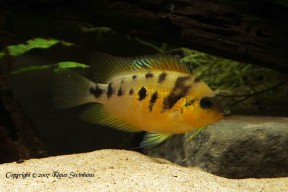
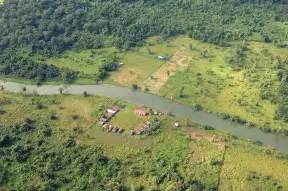

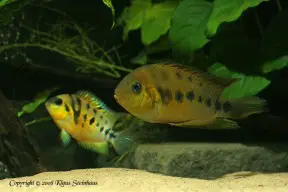
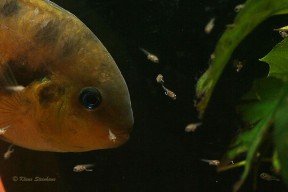

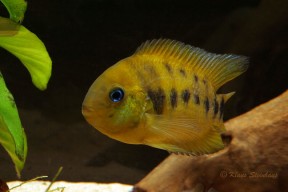
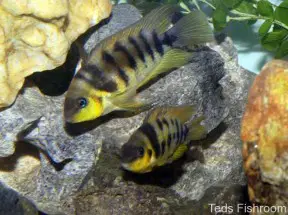

December 20th, 2012 at 11:47 pm
Standard length appears to be incorrect.
December 21st, 2012 at 11:30 am
Quite right Des, thanks a lot. As with many species we already had some contributed photos on file so took the opportunity to perform some basic editing on the profile, too.